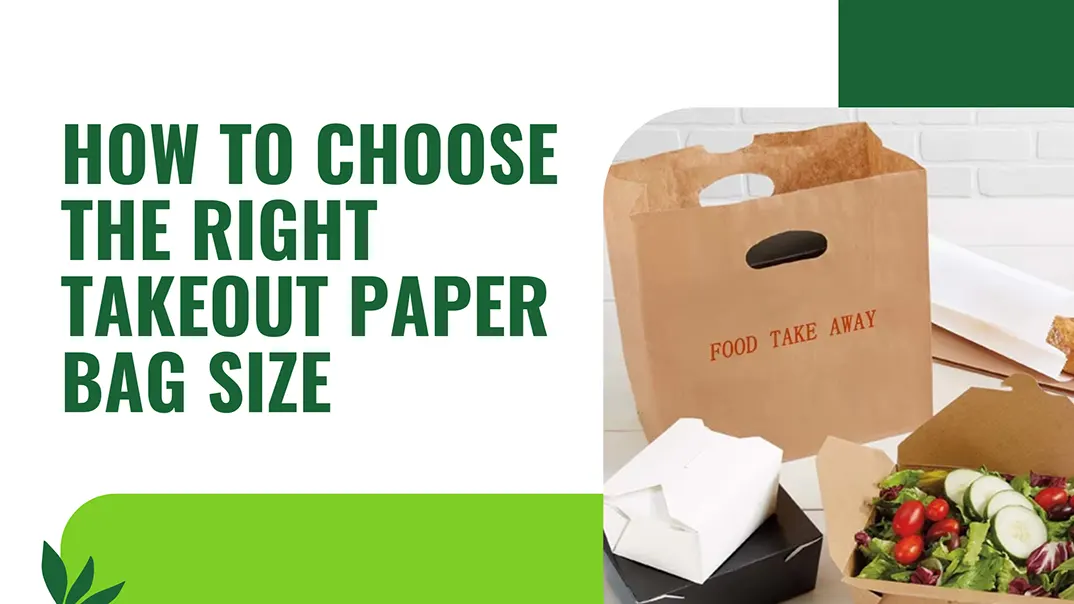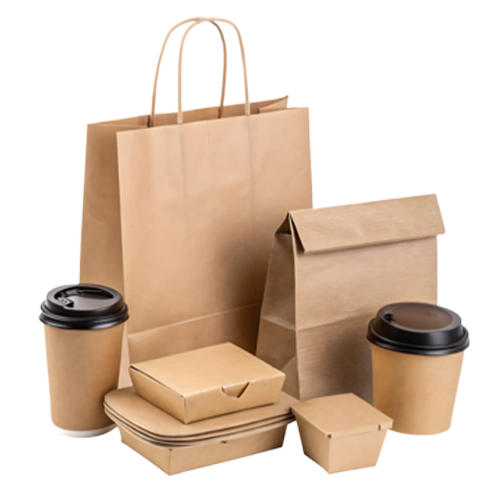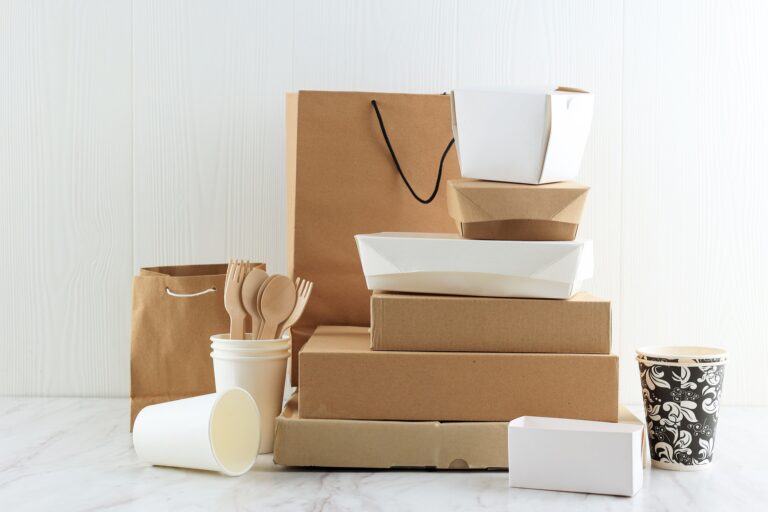Every successful food business knows that customer experience begins long before the first bite. Packaging plays a silent yet powerful role in shaping that experience. A bag that is too large or too small can instantly affect convenience, presentation, and satisfaction.
Understanding takeout paper bag size standards can help streamline daily service, reduce costs, and ensure consistency across multiple locations. It’s a small change that delivers big results in efficiency and customer satisfaction.
In this article, we’ll explore everything you need to know about takeout paper bag size: common dimensions, how to measure correctly, and what to consider when ordering from wholesalers.
Why Does Takeout Paper Bag Size Matter?
Takeout paper bag size influences how your food travels, how it is received by customers, and how your team performs during busy service hours. A carefully chosen bag size ensures your food travels safely, looks appealing, and reflects the professionalism of your service.
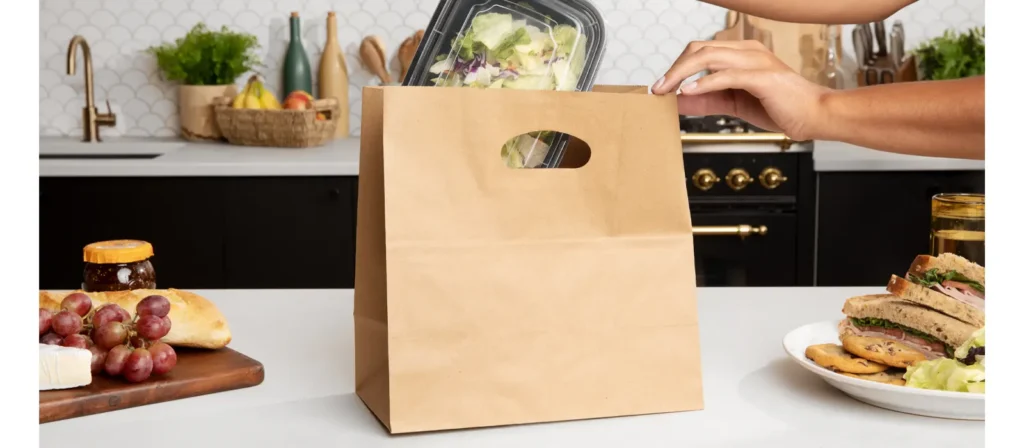
Protects Food Quality and Presentation
When a bag fits well, it keeps containers upright and stable during transport. This helps prevent spills, crushed boxes, or sauces from leaking into the bottom of the bag. Whether you are packing hot meals, delicate pastries, or stacked containers, using the right takeout paper bag size helps maintain both appearance and temperature. Customers are more likely to be satisfied when their food arrives in good condition.
Improves Operational Efficiency
Standardizing your bag sizes based on menu items can speed up order packing and reduce confusion in the kitchen. Staff can quickly match containers to bag sizes without guesswork. Well-fitting bags also allow for better space usage during delivery, helping drivers stack and carry multiple orders safely. Fewer errors and less packaging waste can improve workflow and save time.
Enhances Customer Experience
A properly sized bag feels professional. It is easy to carry, opens smoothly, and holds items securely. When customers receive their food in a neat and organized way, it reflects positively on your brand. The right takeout paper bag size also supports branding efforts, making logos and printed messages more visible and less crumpled.
Supports Cost Control and Sustainability
Using oversized bags leads to unnecessary material use and higher costs. Bags that are too small increase the chance of double-bagging or replacing damaged items. Matching bag sizes to order types allows restaurants to streamline inventory and reduce waste. This not only saves money but also supports more eco-friendly operations.
Understanding Food Paper Bag Sizes
Choosing the right takeout paper bag size requires more than a rough guess. It involves understanding bag dimensions, structural features, and how they relate to different food items. From single-portion snacks to large family meals, selecting the correct bag size helps maintain food quality, improves the delivery experience, and reduces unnecessary packaging waste.
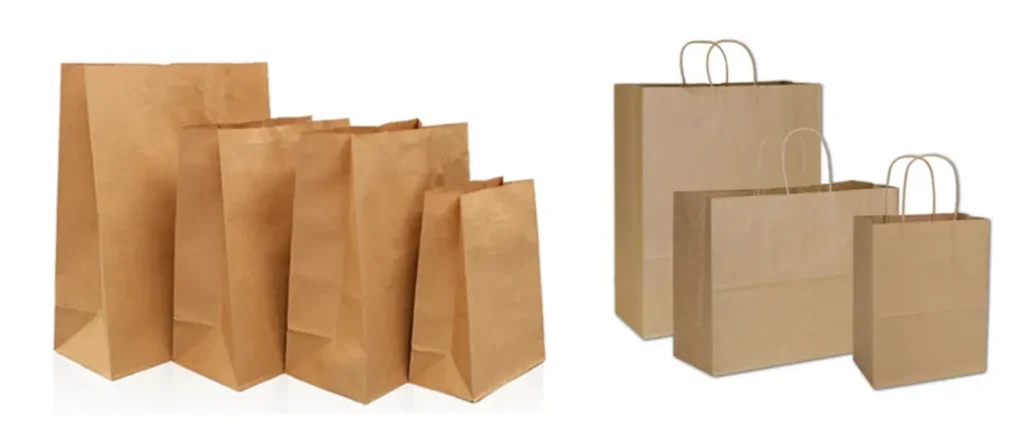
Small Paper Bag Sizes
Small paper bags are typically used for individual items such as sandwiches, pastries, cookies, and light snacks. These bags are compact and easy to store, making them ideal for bakeries, cafes, and convenience food outlets. While they do not offer large capacity, their size ensures that items stay in place and are not jostled during transport. Many small bags are grease-resistant or lined to handle oily or crumbly foods. They are also a great choice for side items included in larger takeout orders.
| Size (W x G x H in inches) | Metric Size (cm) |
|---|---|
| 5 x 3 x 9 | 12.7 x 7.6 x 22.8 |
| 6 x 3.5 x 11 | 15.2 x 8.9 x 27.9 |
| 7 x 4 x 10 | 17.8 x 10.2 x 25.4 |
Medium Paper Bag Sizes
Medium paper bags are the most versatile option and are commonly used for meals with one or two containers, a main course and a side dish, or a drink and dessert combination. This size is popular for lunch sets and standard takeout orders in fast-casual restaurants. Medium bags provide enough space to stack items neatly while preventing them from tipping or collapsing. They often feature sturdy handles, allowing customers to carry meals comfortably without worrying about the weight or contents shifting.
| Size (W x G x H in inches) | Metric Size (cm) |
|---|---|
| 8 x 4.5 x 10.5 | 20.3 x 11.4 x 26.7 |
| 9 x 5.5 x 12 | 22.9 x 14 x 30.5 |
| 10 x 6 x 12 | 25.4 x 15.2 x 30.5 |
Large Paper Bag Sizes
Large paper bags are designed for bulkier orders such as group meals, catering packs, or orders with multiple containers. They have deeper gussets, wider openings, and stronger bases, making them suitable for heavier loads. Large bags are often used by restaurants that offer family meals, combo platters, or special party boxes. To ensure safety and durability, this size typically includes reinforced bottoms and heavy-duty handles. Choosing the right large takeout paper bag size ensures that bigger meals arrive safely and in good condition.
| Size (W x G x H in inches) | Metric Size (cm) |
|---|---|
| 12 x 7 x 12.5 | 30.5 x 17.8 x 31.8 |
| 13 x 7 x 17 | 33 x 17.8 x 43.2 |
| 14 x 10 x 15 | 35.6 x 25.4 x 38.1 |
How Bag Dimensions Are Measured?
Food paper bags are typically measured using three key dimensions: width, gusset (depth), and height.
- Width refers to the front-facing side of the bag when it is standing.
- Gusset refers to the side panels that allow the bag to expand.
- Height is the vertical measurement from bottom to top.
For example, a bag labeled 8 x 4.5 x 10 inches has a width of 8 inches, a gusset of 4.5 inches, and a height of 10 inches. These numbers are essential for fitting your containers properly and avoiding overpacking or wasted space.
What is Considered a “Standard Size” in the Food Industry?
In the food industry, a “standard size” for takeout paper bags refers to the most commonly accepted dimensions used by restaurants, cafes, and packaging suppliers. Standard bags typically fall within 9–10 inches wide, 5–6 inches deep, and 11–13 inches high (approximately 23–25 cm wide, 13–15 cm deep, and 28–33 cm high). These dimensions are large enough to hold most medium-sized meal boxes, drink cups, or lunch sets while still being comfortable for customers to carry.
These sizes are developed based on the average volume of typical food containers, allowing for efficient storage, packaging, and delivery. Choosing standard sizes simplifies procurement and ensures that bags are compatible with widely used food boxes and trays. Standardization also benefits international buyers. When suppliers follow similar size categories, it becomes easier to compare specifications, pricing, and material quality across different regions.
How to Select the Right Takeout Paper Bag Size?
Choosing the right takeout paper bag size involves more than simply fitting food into a container. It requires understanding your menu, measuring your packaging accurately, and considering your customer’s convenience. The following steps and tips will help you make an informed choice that balances function, appearance, and cost.
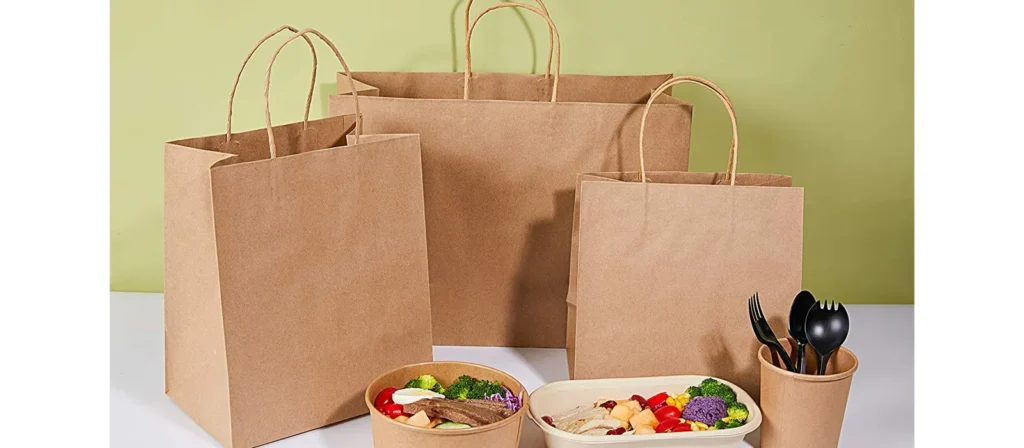
1. Measure Your Food Containers Accurately
Start by measuring the width, depth, and height of your largest food container. Always include extra space for side dishes, utensils, and napkins. When you measure, keep in mind that most suppliers list sizes as width × depth × height, so accuracy is essential for a good fit.
If your container measures 8 inches wide and 4 inches deep, for example, choose a bag that is at least 1–2 inches larger in both dimensions. This ensures a comfortable fit without stressing the bag or risking spills.
2. Consider the Total Weight and Volume of the Order
Different foods have different weight and balance characteristics. Hot dishes, soups, and meals with liquid sauces need stronger paper and a reinforced base. For light bakery items or small snacks, thin kraft paper may be sufficient.
As a general guideline:
- Small bags work well for items under 0.5 kg (about 1 pound).
- Medium bags are suitable for 1–2 kg (2–4 pounds).
- Large bags should handle more than 2 kg (over 4 pounds).
Matching bag size to weight prevents tearing, improves handling safety, and ensures a pleasant experience for customers.
3. Allow Extra Space for Presentation and Branding
Leave a small margin of empty space in the bag to maintain a professional presentation. Crowded packaging not only looks untidy but can also damage food during transport. Extra space also allows room for printed branding, thank-you cards, or promotional inserts without bending or creasing them.
Visually balanced packaging reflects care and attention to detail, helping customers associate your business with quality and reliability.
4. Evaluate Handle Strength and Bag Material
For heavier orders, select bags with strong handles and a higher paper thickness. This improves carrying comfort and prevents tearing. Some takeout paper bag sizes are available in grease-resistant or moisture-resistant versions, which are especially helpful for saucy, oily, or hot dishes. These features protect the bag’s appearance and integrity during delivery or pickup.
5. Test Before Bulk Purchasing
Before placing a large order with a supplier, always test sample bags using your actual food containers. Simulate packing conditions during a busy service or delivery run. This hands-on testing helps verify that the chosen takeout paper bag size fits well, supports the weight, and remains easy for customers to carry.
Testing a few options can prevent costly reorders and ensure your team is confident in the packaging used daily.
Common Mistakes to Avoid When Ordering Takeout Bags
Ordering the correct takeout paper bag size is essential for smooth operations and a positive customer experience. However, many businesses make avoidable mistakes that lead to wasted packaging, damaged food, or added costs. By recognizing these common issues, you can make better purchasing decisions and ensure your packaging matches your menu.
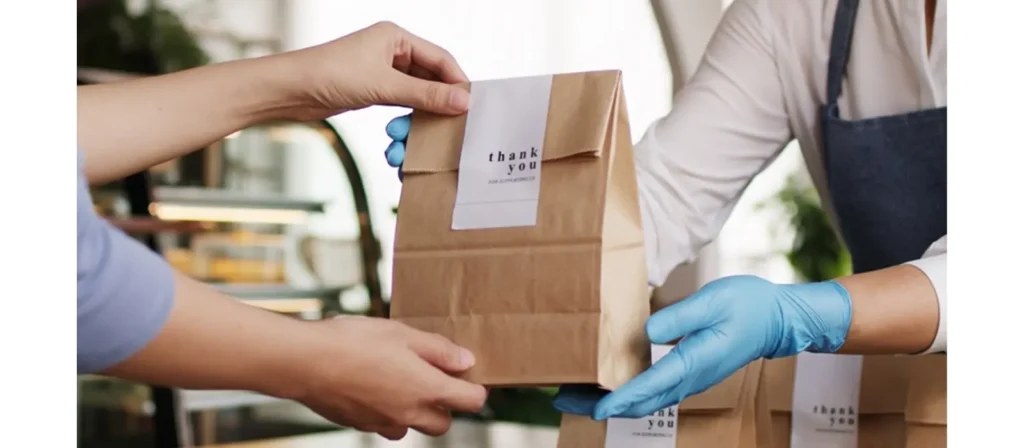
Not Measuring Food Containers Accurately
One of the most frequent mistakes is assuming a bag will fit without checking the exact size of the food containers. Even a one-inch difference in width or height can cause problems during packing. Always compare the base, gusset, and height of the bag to your most commonly used boxes, bowls, or trays. A proper fit prevents squeezing, tipping, or tearing.
Relying on One Bag Size for All Orders
Using a single bag size for every order may simplify storage, but it often leads to poor results. Small items may shift around in a large bag, while bigger meals may not fit at all. A well-balanced packaging system includes at least three sizes to accommodate different food types and order combinations. This approach improves both efficiency and presentation.
Choosing Bags with Weak Handles or Thin Paper
Some bags look durable but cannot handle the weight of a full meal. If the handle detaches or the bottom gives way during delivery, the food may be lost and the customer left frustrated. Check the paper weight and construction quality before placing large orders. Heavier meals and multi-container packs require stronger materials and well-attached handles.
Forgetting to Account for Grease or Moisture
Certain foods, especially fried or saucy items, can weaken standard paper over time. Without a liner or grease-resistant layer, the bag may absorb oil, stain, or tear. It is important to match the material to the type of food you serve. Many suppliers offer eco-friendly options with built-in moisture resistance that still support sustainability goals.
Overlooking Branding and Labeling Potential
A takeout bag is more than just a container. It is also a branding opportunity. Leaving your bags plain or unmarked means missing a chance to communicate with your customers. Printed bags can display your logo, website, or a friendly message, helping to build brand recognition and trust over time.
Ordering in Bulk Without Storage Planning
Buying large quantities of paper bags without thinking about storage can overwhelm your space. Oversized bags also cost more and use unnecessary material when used for small items. It is helpful to calculate usage frequency, available storage space, and order volume before purchasing. This allows you to balance savings with practicality.
Find a Trusted Paper Bag Wholesaler
Working with a reliable paper bag wholesaler is essential for any business that offers takeout, delivery, or packaged food. A dependable partner helps ensure that the right takeout paper bag size is always in stock, the quality remains consistent, and customization needs are met on time. Choosing the right supplier can reduce stress, cut costs, and improve customer satisfaction.
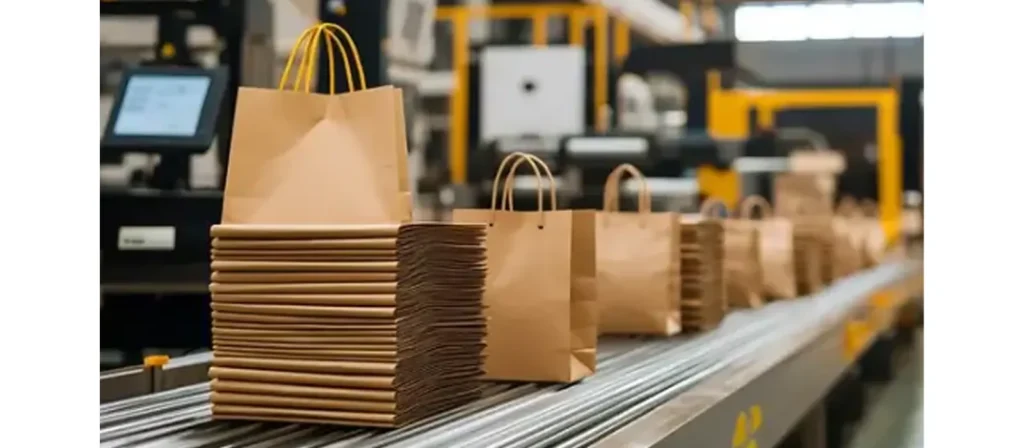
Look for Industry Experience and Product Range
The best wholesalers understand the food service industry and offer a wide range of bag sizes and materials. From small bags for pastries to large bags for catering orders, a strong supplier will help you match the right bag to your packaging needs. Ask if they offer eco-friendly options, grease-resistant liners, and different handle types. A diverse product catalog makes it easier to standardize your packaging while maintaining flexibility for different menu items.
Ask About Customization Capabilities
Brand visibility is important, even with something as simple as a takeout bag. A trusted wholesaler should provide options for logo printing, color matching, and customized sizes. Some suppliers also offer low minimum order quantities for branded bags, which is helpful for smaller businesses or seasonal promotions. Confirm their design support and turnaround times before committing to a bulk order.
Evaluate Reliability and Communication
Strong communication is a key part of any wholesale relationship. Choose a wholesaler who responds quickly, provides clear quotes, and delivers according to schedule. Delays or poor coordination can result in stock shortages or customer complaints. Reading client reviews, checking references, or requesting a sample order can help you evaluate whether the supplier is trustworthy.
Review Pricing and Delivery Terms
Cost matters, but it should never come at the expense of quality or reliability. A reputable wholesaler will be transparent about pricing, discounts for volume orders, and delivery timelines. Ask if they provide flexible shipping options or warehousing services. Long-term value often comes from a supplier who offers fair prices and consistent service, not just the lowest quote.
Choose Million Pack as Your Trusted Partner
Million Pack is a professional manufacturer and global supplier specializing in eco-friendly food packaging solutions, including takeout paper bags, food containers, and cutlery. With more than 20 years of manufacturing experience, Million Pack delivers high-quality, customizable, and compliant packaging for businesses of all sizes.
- Comprehensive Packaging Expertise
We offer thousands of SKUs and launch new packaging products weekly, adapting to evolving market needs. - Custom and Brandable Solutions
Full support for OEM and ODM services, including offset and flexographic printing on paper, kraft, and bagasse materials. Logos, labels, and sizes can be fully customized. - Certified Quality
Our products hold SGS and TUV food-grade certifications, ensuring both safety and compliance. - Global Export Support
Million Pack has exported to more than 30 countries across North America, Europe, Australia, and Asia with consistent product quality and compliance. - Reliable Logistics Capacity
We provide verified international shipping records and professional support to ensure smooth delivery to every client.
Conclusion
Choosing the right takeout paper bag size is not just a small operational detail. It plays a direct role in preserving food quality, supporting your brand image, and creating a seamless customer experience. Whether you are a local café or a growing food chain, smart packaging begins with sizing. Make it part of your quality control strategy, and your customers will notice the difference with every order.

